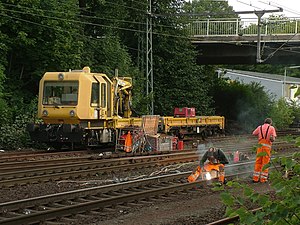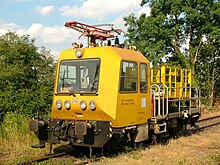GBM GAF
| GAF100R | |
|---|---|
|
GAF100R in use for rail welding work
|
|
| Numbering: | 97 17 48 97 17 49 97 17 50 97 17 52 97 17 53 97 17 55 (see table) |
| Manufacturer: | Track construction mechanics |
| Year of construction (s): | (see table) |
| Axis formula : | B. |
| Gauge : | 1435 mm ( standard gauge ) |
| Length over buffers: | 9,080 mm |
| Height: | 3,410 mm |
| Width: | 2,600 mm |
| Payload: | 5.0 t |
| Service mass: | 15.0 t |
| Top speed: | 100 km / h, 120 km / h with GAF 200 |
| Installed capacity: | 169 kW (230 PS), 339 kW with GAF 200 |
| Driving wheel diameter: | 750 mm |
| Motor type: | water-cooled 6-cylinder diesel engine |
| Motor type: | MAN D 0826 LOH 07 |
| Rated speed: | 2400 min -1 |
| Power transmission: | diesel-hydraulic |
| Tank capacity: | 300 liters |
| Brake: | indirect block brake |
| Train control : | PZB 90 |
| Train heating: | no |
Since 1994 the company Gleisbaumechanik in Brandenburg an der Havel has been selling auxiliary vehicles for various activities in railway construction under the name GAF (abbreviation for "Gleisarbeitsfahrzeug") . These are two-axle vehicles that are equipped with different bodies on two different chassis , depending on the application .
At Deutsche Bahn , the vehicles are referred to as the 741 (GAF 100) and 742 (GAF 200) series.
development

In the track construction mechanics company in Brandenburg, Rottenkraftwagen were built for the DR, but also for other railway companies , from the 1960s . Shortly after reunification , the company initially developed the SKL 26 series with a completely redesigned driver's cab and chassis and modular superstructures as the successor series for the SKL 25 Rottenkraftwagen built from 1977 onwards , in order to be able to adapt the vehicle to different tasks.
Just three years later, the GAF was redeveloped, which received a more powerful engine (169 kW) and an improved chassis and can therefore travel at 100 km / h. The modular construction of the superstructure was retained, as was the external shape of the driver's cab (with a different arrangement of the headlights and doors), while regular pulling and bumpers were attached to the front and rear .
In 1996, a further development with the designation GAF200 was presented, which offers space on a larger chassis for a more spacious driver's cab and again comes up with more power (338 kW) and a higher top speed (120 km / h).
variants
In the years that followed, the GAF100 was manufactured with superstructures for various tasks, the different versions are distinguished by letters afterwards, R stands for standard gauge , H, for example, for equipping with an aerial work platform for catenary work .
| model series | Auxiliary vehicle designation | Type designation of the manufacturer | Years of construction |
|---|---|---|---|
| 741.1 | 97 17 50 | GAF100R | 1994-1997 |
| 741.2 | 97 17 52 | GAF100R / A | 1997-1998 |
| 741.3 | 97 17 53 | GAF100R / V | 1997-2000 |
| 741.4 | 97 17 48 | GAF100R / VL | 2002 |
| - | 97 17 49 | GAF100R / H | 2002-2003 |
| 741.6 | 97 17 50 | GAF100R / M | |
| 742 | 97 17 55 | GAF200 | 1998 |
Starting in 1996, Deutsche Bahn purchased 150 of the original GAF100R version to replace the Rottenkraftwagen of the predecessor railways such as the Klv 53 or Skl 25. Further vehicles followed in the variants GAF100R / V (with crane Palfinger 11000A), GAF100R / A (with crane Palfinger 9001A), GAF 100R / H (with lifting platform) and GAF100R / VL (with crane Palfinger 11000A). Some vehicles of type GAF200 were also procured for maintenance work on main traffic routes.
commitment
The high top speed of the vehicles made it possible to combine the previously numerous railway maintenance offices into a few larger bases and still be able to reach construction sites quickly with the vehicles . The vehicles are used in particular on smaller track construction sites or for preparatory and follow-up measures on large construction sites. The variant with aerial work platform is used for work on the overhead contact line and can replace a tower car for smaller work .
Individual evidence
- ↑ Overview of the railway service vehicles manufactured in Brandenburg
- ^ Vehicle training auxiliary vehicle BR 7 .. Deutsche Bahn AG, DB Training, accessed on March 1, 2019 .
- ↑ Information about the manufacturing company at lokmacher.de
- ↑ https://www.nebenfahrzeuge.de/index.php?nav=1411974
- ↑ Thomas Estler, Deutsche Bahnienstfahrzeuge - since 1948, ISBN 978-3-613-71506-6 , transpress


